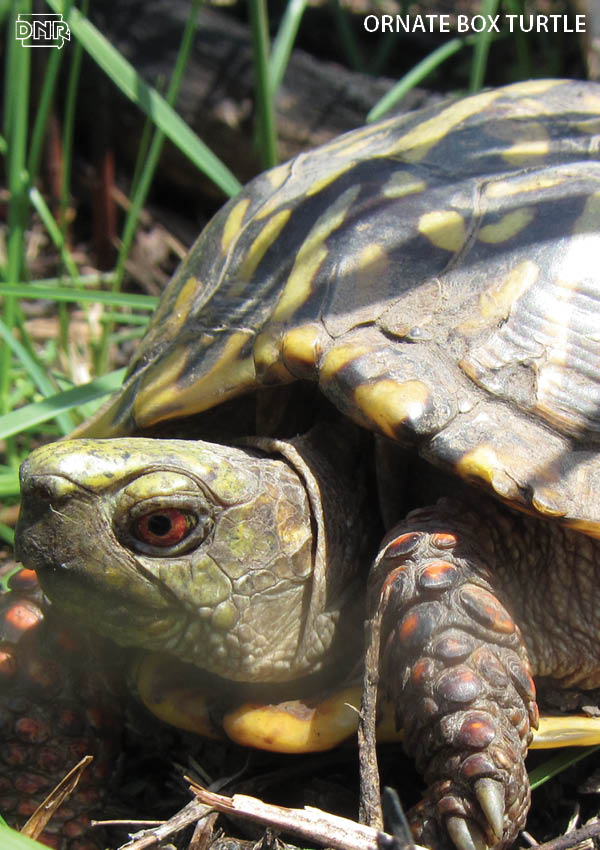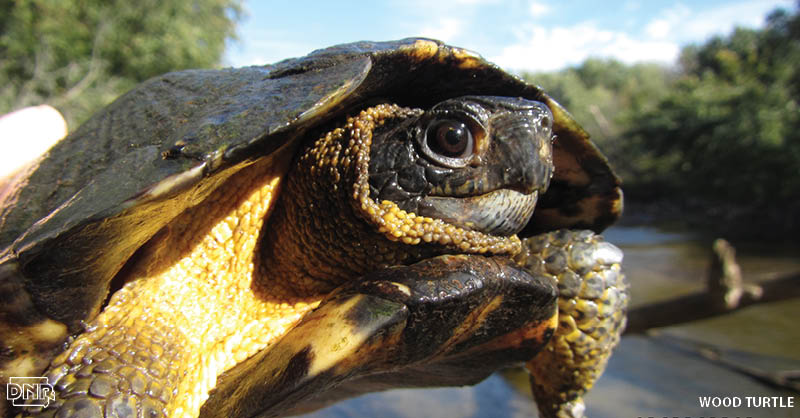Whether they walk on land or paddle in the river, the 13 species of turtles we have in Iowa are much more complex than meets the eye - many tout extensive lifespans and specific habitat needs. See how much turtle trivia you know:
Hungry Dance
An endangered species living near woodland streams in northeast Iowa, the wood turtle gets its name from the patterns on its intricate brown shell, which looks like the growth rings of a tree. These turtles are omnivorous, with a large part of their diet consisting of plant material like berries and dandelions. However, they also eat insects, earthworms, mollusks and even carrion. To trick their food to come to them, wood turtles will stomp their feet repeatedly on soft soil to draw earthworms to the surface, which likely think the vibrations come from falling rain. As they emerge from the soil, the earthworms are promptly eaten by the clever hungry turtle.
 Snap To It
Snap To It
The largest turtle species in Iowa, mature snapping turtles can easily average the size of a dinner plate. Easily identifiable by their long, saw-toothed tails, prominent beak, and surly disposition, snappers live in permanent bodies of water all over the state. Snapping turtles will occasionally cross roads and highways, particularly females during their egg-laying season in early summer. Few of the eggs they lay will survive the 50 to 60 days until hatching due to heavy predation from raccoons, skunks, ferrets, snakes, coyotes, bullfrogs, otters, herons and gulls, and the surviving quarter-sized hatchlings continue to be prey for various predators until they reach approximately a three-inch shell size. At this point they start becoming difficult to fight and swallow. Like some other turtle species, the snapper hatchlings’ gender is strongly affected by the temperature of the nest in which they incubate. A cool nest will result in a high proportion of male hatchlings, while a warm nest will yield mostly females.
Placid Paddlers
There are two species of softshell turtles in Iowa: spiny and smooth. Although both are very difficult to catch due to their speed in water, spiny softshell turtles will scratch and bite furiously to escape capture, whereas smooth softshell turtles are rather docile when handled (note: it is legal to catch these turtles by hand in Iowa). Male spiny softshell turtles can be easily identified by prominent dark spots on their light green shells. All softshell turtles’ shells resemble a leathery pancake, and in some specimens the turtles’ spine and ribs are clearly visible underneath. These turtles also have extended snorkel-like noses and long necks, which they use to breathe while hiding from predators and prey under the sand or mud of the river bottom. Their skin is also substantially more permeable than that of hard-shelled turtles, and a softshell turtle can obtain sufficient oxygen in through their skin to remain submerged for several hours.
 Soupy Supper
Soupy Supper
Perhaps the best-known Iowa turtle, other than the snapper, is the northern painted turtle (sometimes just called a painted turtle). They will commonly bask in the sun for much of the day, sometimes in groups. Although they are omnivorous, these and some other species of turtles cannot move their tongues, and thus are incapable of swallowing their food out of water. They live in a variety of permanent water bodies throughout Iowa, but individuals living in muddy-bottomed waters have been reported to grow faster than those found in sandy or gravelly environments. Their dark green and yellow stripes are similar to those of a slider, but painted turtles lack the distinctive red “ear patch” present in sliders. It’s important to know the difference because painted turtles can be legally taken in Iowa with a valid fishing license, whereas endangered sliders are completely legally protected.
Map Mimics
Map turtles, so named because of their dark shells with bright yellow lines (although the bright markings may obscure with age) have three similar – but distinct – species in Iowa. Still, different patterns of bright yellow blotches on the head can be used to determine a map turtle’s species throughout its life. False map turtles have a singular angled blotch that looks like a backwards letter “L” behind each eye. Common map turtles have a singular round blotch in a similar position. Ouachita map turtles have the fanciest pattern, with three round or oblong blotches: one on the lower jaw, one below the eye, and one behind the eye. Ouachita map turtles also have a distinctive crested ride down the middle of their shells, called a keel. Iowa map turtles are seldom found far from the Mississippi River, and all three species are protected. Although they commonly bask in groups with other turtle species (commonly northern painted turtles), map turtles are very wary of danger and will abandon a basking site much more readily than other species.
Closed for Business
Aptly named, ornate box turtles are special in Iowa for several reasons. These fancy reptiles have a domed, tortoise-like shell with abundant orange and yellow streaks on a dark green field. Their dark skin is usually covered in similar markings, and males eyes are strikingly bright red. They are also the only fully terrestrial turtle in the state, and small populations exist in various locations with open sandy areas. They can live to be 50 years old, commonly living up to 25 in the wild, but their populations are very low and declining because they lay very small clutches of eggs in very specific habitats, and abundant various predators eat turtle eggs. The surviving terrestrial turtles’ feet are particularly stumpy and have long claws for digging. However, if somehow placed in deep water, ornate box turtles can actually swim quite well due to fat deposits under their shells. Most ornate box turtles are not even capable of submerging themselves because this fat makes them float so well (note: do not intentionally place an ornate box turtle in water. It may still drown, and it’s not legal to either capture or kill these endangered animals). These turtles can also completely retreat into their shell. While most turtles will tuck in their head, legs, and tail in case of danger, a determined predator can still grab at the turtle’s limbs and eventually get a meal. Not so with ornate box turtles. A special hinge in the lower half of their shells allows part of the lower shell plate to bend upwards, protecting the turtle’s face and limbs from attacks. While predators may try to crush or pry the shell open, usually the turtle gets kicked around, the predator gets bored, the predator leaves, and the turtle goes on its merry way. Blanding’s turtles are the only other Iowa species that uses this trick.
All of the turtles mentioned here have few natural predators when mature, nd are primarily threatened by humans. Habitat loss is an overwhelming factor in their decline, but many turtles are also threatened by traffic. If you see a turtle on the road, especially if you can identify it as an endangered or threatened species, call a local conservation or animal control authority and let them move the animal to a safer location. Even turtles whose shells have been damaged by a collision can sometimes be saved by qualified wildlife rehabilitation staff.
